#poduromorpha
Text

A giant springtail (Holacanthella sp.) in Aotearoa
by Tony Jewell
#giant springtails#springtails#holacanthella#Neanuridae#Poduromorpha#Entognatha#arthropoda#wildlife: aotearoa#wildlife: oceania
290 notes
·
View notes
Text
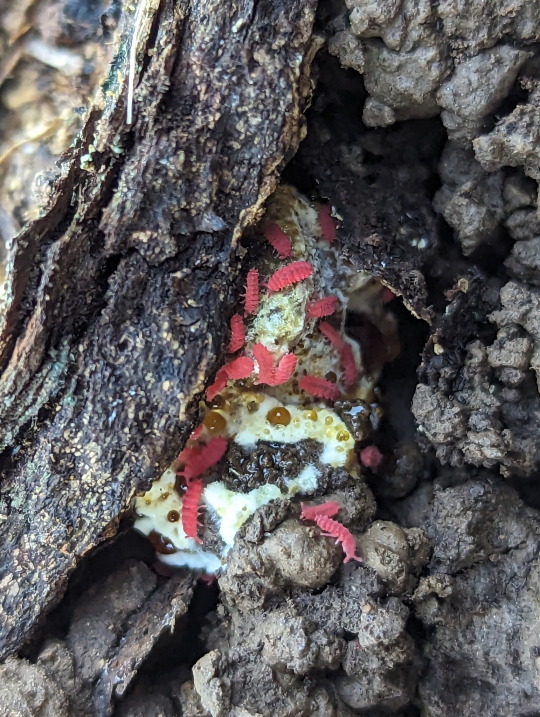
Springtails feasting on a fungus.
24/07/23 - Poduromorpha sp.
#Poduromorpha#Plump Springtails#Collembola#Springtails#Entognatha#Entognathans#bugblr#arthropoda#arthropods#invertebrates#invertblr#unidentified
99 notes
·
View notes
Text
Choose Your Flavor of Poduromorpha Springtail:
Peach, Grape, Plum, Smol




110 notes
·
View notes
Text
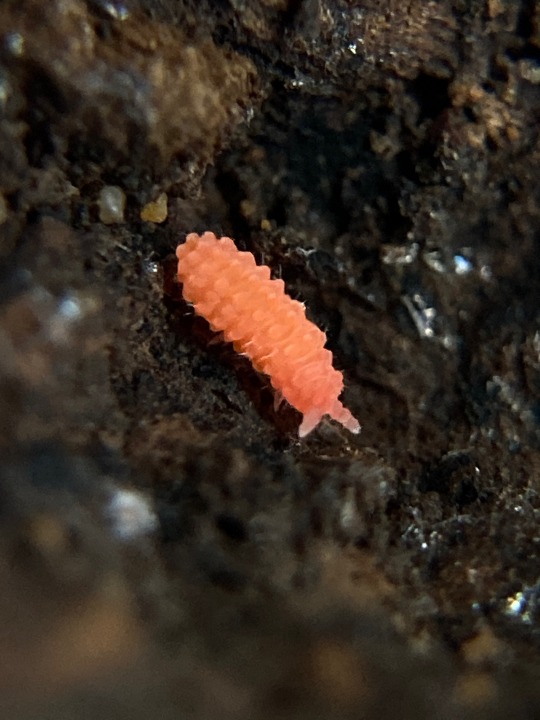

gubby
122 notes
·
View notes
Note
could you please post about wasp-mimicking moths? they’re some of my favorites
absolutely! very cool lil guys. also for your consideration, if i may... this lil guy?
♡loop
2 notes
·
View notes
Note
taxa rankings: each order (or superfamily if you're feeling super granular) of collembola
I don’t really have very strong feelings about any springtails. they’re all very cute and unique and a joy to see, and hard to find any flaws in. I look at a springtail and say “yes”
Entomobryomorpha - fluffy! long! thank you for keeping my bugs houses clean. A
Poduromorpha - fat little nugglets. a pat on the head. A
Symphypleona - roundlings! so full of color and can leap like nobody’s business. A
Neelipleona - it’s animals! A
43 notes
·
View notes
Note
Can I suggest springtails for your iNat requests -- specifically Poduromorpha/Neanuridae? They are wonderful, incredibly underappreciated creatures and there are some beautiful observations on iNat -- if you want to see the real stunners, check out Pseudachorutinae
Thank you for writing in! Springtails are delightful creatures that I hope to photograph more, but they like to spring out of frame! It always seems I have more luck photographing them unintentionally than I do intentionally. Maybe they want to surprise you post-upload when you find them scattered in the dirt behind a bug so many times their size!

Dragon Springtails (Genus Acanthanura) © Nick Porch [ID: A dark-bodied arthropod with six orange legs and orange bumps and horn-like structures on its head and back. The protrusions are longest on top of it's head, along it's sides, and at it's rear. /End ID]
Truly stunning! This individual was observed in Southeast Australia. The name Dragon suits the horns on it's head well.

Seashore Springtail (Anurida maritima) © Evan C [ID: Several dozen bluish grey springtails cluster together as they float on the surface tension of the water.]
This raft of springtails was observed in Coastal Maine, US. This species is considered cosmopolitan but is apparently not found in parts of the British Isles and the Baltic Sea. If anyone seeing this has access to a rocky coast or intertidal zone, see if you can find an aggregation of these guys! They use pheromones to group together and float easily due to their small size and hydrophobic bristles on their body.
Thank you again for the request, I learned a bit more and grew more curious!
#nature photography#wildlife photography#ecology#zoology#nature#springtails#killy killy#ask#inaturalist#entognatha#photography
18 notes
·
View notes
Photo

Giant springtail (Holacanthella paucispinosa)
Photo by Gil Wizen
#up to 1.7 cm long!! holy shit!!!!#giant springtail#springtail#holacanthella paucispinosa#holacanthella#uchidanurinae#neanuridae#neanuroidea#poduromorpha#collembola#entognatha#hexapoda#pancrustacea#arthropoda#panarthropoda#ecdysozoa
113 notes
·
View notes
Photo





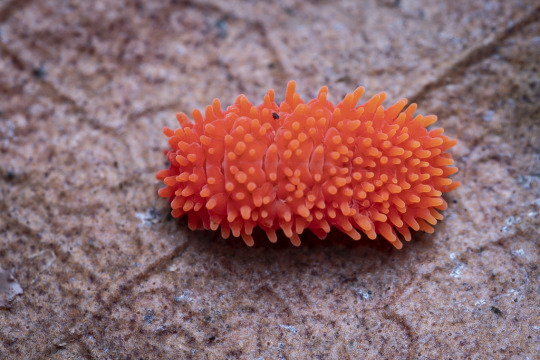
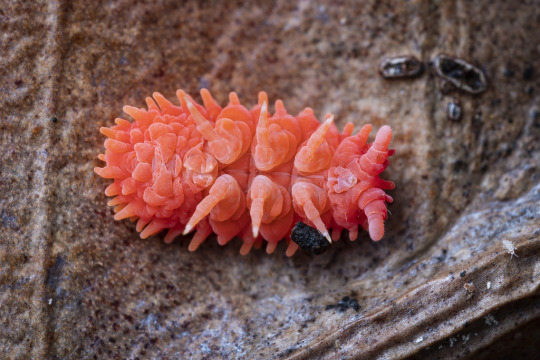
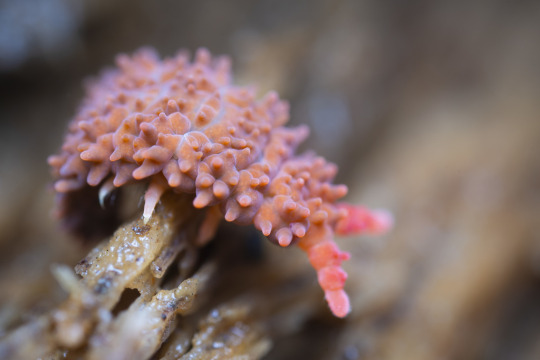


Red short-legged springtails, Caledonimeria mirabilis, subfamily Neanurinae, order Poduromorpha (plump springtails)
All photos by damienbr
#animals#curators on tumblr#bugs#springtail#short legged springtail#plump springtail#Caledonimeria mirabilis#one nice bug#macro
3K notes
·
View notes
Photo


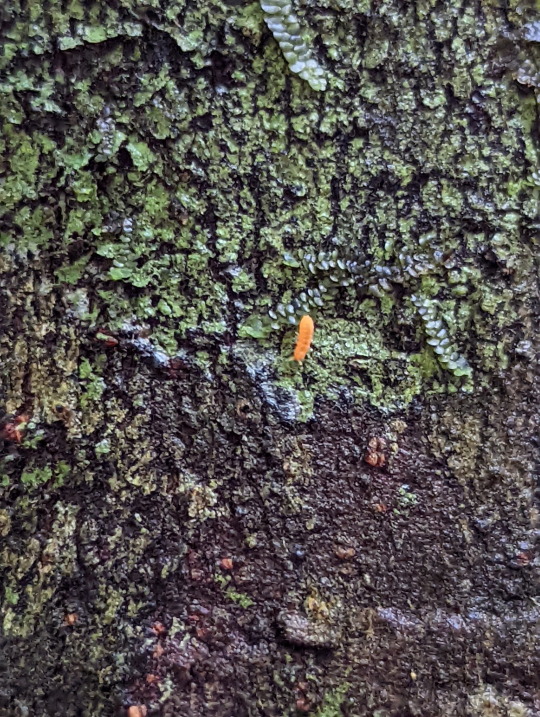

Tiny but Plump
Unidentified, order Poduromorpha
06/07/22
#Poduromorpha#springtails#plump springtails#Entognatha#Entognathans#Collembola#invertblr#invertebrates#Arthropods#Arthropoda
30 notes
·
View notes
Text
Got to introduce my friend to a Neelid yesterday, which was delightful. Just an adult human excitedly trying to point out a particular pollen grain under a log, and the other human lighting up when she sees it move 😀
The Neelid is smaller than the head of a barely visible Poduromorpha springtail! 🥹

37 notes
·
View notes
Note
do you know anything about globular springtails? i found them by chance looking through a photographers portfolio and im obsessed with them but theres like no information about them online
I sure do know some things about globular springtails!
Springtails, or collembola, for the uninitiated, are non-insect hexapods, living mainly in soil and on/near the surface of still water. They’re very small, and very abundant, with some figures estimating that there are over 100,000 springtails for every square meter of soil on Earth.
They're divided into three major orders, shown respectively in the image below: the Entomobryomorpha (slender springtails), the Poduromorpha (plump springtails), and the Symphypleona (globular springtails).

Globular springtails get their name from their delightfully globular shape, having fused abdominal segments and a very round, near-spherical body. Like their fellow collembola, they are voracious omnivores, working to break down scraps of fungi, bark, and other decaying organic detritus into soil in whatever damp crevices they can find -- though globular springtails tend to prefer a higher humidity still, second only to some wholly aquatic species in Poduromorpha.
All collembola, as their name suggests, have a collophore: an tube-like organ on their underside that helps them to regulate moisture and steady themselves on uneven surfaces. Unique to the globular springtails, however, is the presence of two long, eversible “tubes” that allow them to groom themselves, and coat their bodies in a waterproofing fluid so as to float more easily on the surface of puddles and ponds. This can be seen in great clarity in this excerpt from a BBC documentary.

One of the most common genera of globular springtails, Sminthurides, contains a particularly interesting (and adorable) species: Sminthurides aquaticus (seen above). They live on or near the surface of water, and are notable for their wonderful courtship dance, in which the larger female will lift a smaller male by his antennae, and will spin him around. This can continue for some time and they are even capable of jumping while doing this dance. It’s one of my favorite tidbits of information about springtail behavior, and really shows how varied their behavior and lives can be.
(all images sourced from and copyright Andy Murray)
Additionally, if you ever want to find more information abut springtails, I highly recommend the website of the world’s foremost collembola expert, Frans Janssens: collembola.org
437 notes
·
View notes
Text
^ Sorry for the extremely late response, I've been busy ever since I graduated, so I can't reply to all the DMs and asks I get 😣!
For people asking: Yes, this is a springtail. As in, "springtail" is not my nickname for it, it's really in the subclass Collembola. Specifically, it's in the order Poduromorpha, family Neanuridae. I'm not sure what this is called in America (I live in Singapore 😅), but it's just called "large orange springtail" here. You can get this from plant stores or isopod breeders



^ They are pretty easy to care for, just need to keep them moist. The ones in the original post are individuals living with my isopods, but I do keep a separate "pure" culture of just orange springtails. They live in a cookie jar with soil, moss, leaves and some random rocks 😂
They eat the same bug pellets as my isopods, but I also give them raw rice and organic sweet potatoes (they really like sweet potato)
I'm not sure if they can jump, but I've never seen mine jump. They are just incredibly chonky and shy. They crawl around like round orange potatoes 🤣. I highly recommend them as pets 😂. They are low maintenance and breed pretty fast
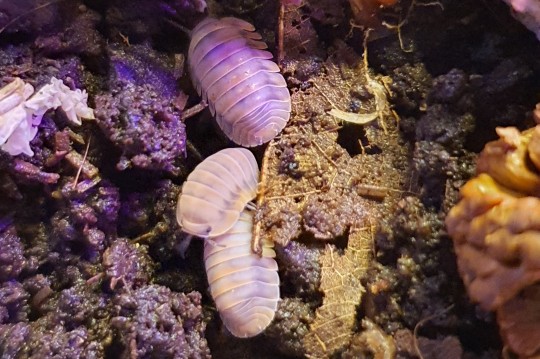
^ For those asking about my annoying isopod named Dante: He's a tropical Thai Cubaris species. I'm not sure what his scientific name is, but he's referred to locally as a "Mango Sticky Rice Isopod" 🥭
He's about the same size as the Rubber Ducky isopod avaliable in America, but this species doesn't really burrow in the soil to hide
(Mine doesn't burrow much at least. I'm not sure about the rest of the species. Mine only dig burrows to sleep in, but they are generally walking and resting out in the open. They aren't bothered by me cleaning the enclosure, Dante even eats food from my hand. He's a chill little guy)
(If you can get these, I really recommend them as pets cos they don't hide. They are very friendly little guys 😂)
30 notes
·
View notes
Photo

Sitting atop some decaying mushrooms are hundreds of vibrant blue Poduromorpha Springtails (Collembola). Springtails are named for an almost mechanical jumping organ under their tail. This allows Springtails to jump 10-15cm. At 2mm long that is a fair distance. It's the equivalent of me (6'2") jumping 9.5-15m. These have become a frequent appearance in my current photographs from Seaward Bush in Invercargill. . . . #entomology #mycology #invercargill #macro #macrophotography #photography #insect #mushrooms #newzealand #mirrorless #sony #sonya6000 #sonya6000club #sonyalpha #nofilter #bush #forest #beautiful (at Invercargill, New Zealand)
#macrophotography#mycology#sonya6000club#mushrooms#photography#forest#sonyalpha#mirrorless#bush#sony#sonya6000#entomology#insect#beautiful#macro#invercargill#nofilter#newzealand
0 notes




